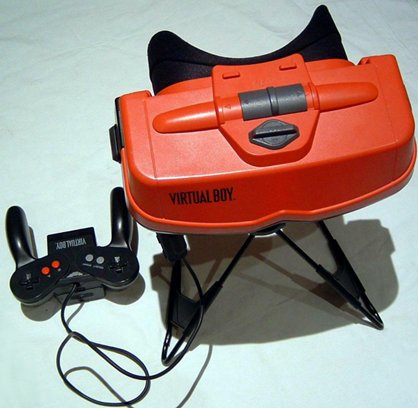The Unfulfilled Promises of Virtual Reality
What the hell happened to our glistening electronic landscapes?

Tom Caudellcoined the term “augmented reality” (AR) in 1990, but the concept of artificially modifying our perceptions of reality is very old. In a lose sense, any artistic endeavor can be considered an act of augmenting reality, especially those which manipulate perspective, such as trompe l'oeil (literally, "trick the eye") paintings. (Right: Pere Borrell del Caso, Escaping Criticism, 1874, National Gallery of Art, Washington D.C.)
In the modern sense, augmented reality refers to the integration of real world and computer generated data. In this sense, the HUDs fighter pilots are accustomed to are forms of augmented reality.
Simple HUDs are cool, but as a child, I was fairly certain that by now I’d see things the way robot vision was always portrayed in movies - grainy text would tick along the bottom of my vision, identifying well-muscled men as potential threats, three-dimensional grids would overlay everything for some reason, and the answers to all my homework assignments would materialize in front of me.

Above: I can has neural-net processor?
In the 1988Whole Earth Review interview I mentioned earlier, Lanier suggested that after putting on our virtual reality gear, we would be presented with a virtual version of the room we were in. Our furniture would be replaced with virtual furniture (so we don’t bump into it), and new virtual elements would be spawned within the room. Ideally, one day I’ll put on my sunglasses and see virtual fish floating through downtown San Francisco, an arrow indicating the direction to my current destination, and an avatar representing a distant friend who has decided to chat with me.

A lot has actually happened in the department of augmented reality since I was just a boy dreamer. The boring utilitarian applications aside (like dropping that white bar over the first down line in televised football games), gaming applications are being experimented with extensively, and will likely be one of the big driving forces for other augmented reality applications (aside from military research).
Essentially, any game that superimposes virtual elements on video in real time can be considered an augmented reality game. The latest is You’re in the Movies, which dynamically cuts out the bodies of its players and places them into virtual scenes. Not exactly Minority Report, but it will do as an example.
Sign up to the GamesRadar+ Newsletter
Weekly digests, tales from the communities you love, and more

Above: OH MY GOD IT'S LIKE SHE'S IN A REAL MOVIE!
The much cooler applications involve headsets which overlay 3D models onreal space. Unfortunately, the headsets are rather large at the moment, and generally have to be connected to bulky wearable computers (not exactly the magic sunglasses I envisioned). These headsets must be not only capable of calculating spatial geometry well enough to realistically superimpose computer generated 3D objects into real space, they must also track eye movement and have the processing power to render the objects in the first place, all in real time. Film studios get to spend months working on special effect scenes – these systems have milliseconds. (Right:A conceptualization of theTinmith AR system, 2006)

Clunky or not, the technology already exists. The barriers now are in regards to size and horsepower. To create effective consumer AR headsets, everything needs to be smaller. When we can pack the power of a couple PS3s into a pair of sunglasses, bundled with batteries capable of powering them, we can have all the augmented and virtual reality we want. Expect Japan to be first on the scene with virtual girlfriends.

Of course, you won’t be able to touch that virtual girlfriend – she’s just a 3D model being projected into your vision. Star Trek wouldn’t have any of that, concocting a device which converts photons into physical matter. Sorry, it’s not so plausible.

Certainly there have been creations that sort of look like holodecks, projecting 3D renders onto allsix surfaces of a room, as well asholographic displays which no longer require stereoscopic headsets, but nothing that comes close to that whimsical TNG episode in which Picard and company are stuck in 1941 San Francisco.

It’s about, as I have already suggested, miniaturizing technology and increasing processor power. Consider all of the elements I have described packaged into one affordable consumer device – a sleek wearable stereoscopic headset which tracks head motion, eye motion, expressions, and neural activity. Add gloves which track hand motion and a highly open-ended MMOG and…
You’ve got everything you need to navigate and interact with a virtual world. The next generation of neuralheadests should be able to take care of basic motion in space (without having tostand in a hamster ball), head and eye tracking will allow you to look around, and motion sensing force feedback gloves will allow you to interact with objects (guns, swords, BDSM whips) and menu systems. Add augmented reality functionality, and you can turn your office building into a war-zone, or your bedroom into a 1950’s bar, placing, as Lanier suggested, virtual objects over the real objects in your surroundings.

Above: The technology is still far too expensive to make Home Reality Engines possible just yet. Even at the affordable end, theHeadplay head mounted displaycosts about $500, and it's justastereoscopicdisplay - no head or eye tracking
It’s no holodeck, but it’s perhaps even more advanced that what Lanier described in the ‘80s when he coined the term “virtual reality,” and all of the required elements already exist in rudimentary forms. The revolution will occur when VR gadgets are no longer designed as disparate peripherals intended to mesh with standard games, and are integrated into singular “VR consoles” for which triple-A game titles are specifically designed. Sega tried once with Sega VR, and that didn’t quite pan out. Neither did Nintendo’s Virtual Boy, but it was designed to exploit the '90s VR hype, not as a serious attempt to build a virtual reality console (the technology simply wasn't available).

Above: Fail
The hype surrounding virtual reality may have faded to an extent, but with the popularity of MMOGs and the inevitable cooling-off of the "casual gaming" boom, I expect VRto regain some of its glamourous draw, and notjustamongst speculative dreamers - console manufacturers will regain interest as well. I would be surprised if consumer devices of the grade I have described aren’t available within the next 10 years. Yeah, I know it has all been said before -predicting the future is hard - but if I'm right, you can be sure that I'll be one of the first to assume the body of an electric phantasm and take a swim in the binary oceans of The Metaverse.
Hear more about this article inTalkRadar.
Aug6, 2008



